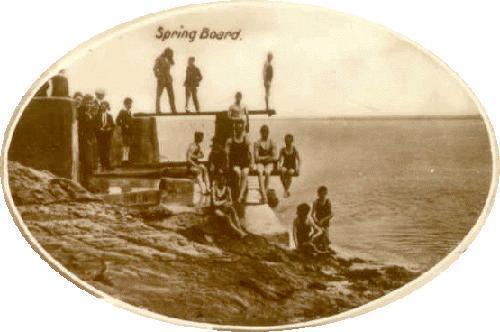
|
Papers: List of recent meetings |
De La Salle by Paddy Sexton |
|
The Springboards at Red Island, Skerries |
|
The large attendance at the November 2002 S.H.S. meeting heard a most enjoyable lecture by Hugh Ryan entitled "The Springboards at Red Island". Hugh spoke from an experience of almost 50 years swimming there and it was obvious that he loves the place - here is an excerpt. "The Springboards" is a vestigial name like "Gallows Hill". The gallows are gone and the springboards are gone. They were put up at a time when the legal attitude to having an accident was "on your own head be it". Now the Council is so afraid of litigation that they won't raise anything above the level of high tide for fear that somebody will hurt himself off it. I know that it's playing it safe but it is nonetheless a pity that something which was very much a part of Skerries for about eighty years is no longer with us. I suppose the first visitor of note to visit the Springboards was St. Patrick and he made a very big impression when he came there - it's a size fourteen because I measured it - and I tried to work out how he embedded himself in the rock. I understand, though I've never seen it that there's another size fourteen footprint on Church Island, where he took off, and he had to launch himself at a very high trajectory to get over Colt Island. He must have come down with quite an impact when he landed at the Springboards. There were no Springboards of course in those days. The actual bathing place was constructed by the Visitors' Association 1470 years after St. Patrick arrived. There is a bronze plaque on the step and it refers to this fact. The visitors to Skerries were to some extent a breed apart from the ordinary hoi polloi. There are in existence, here and there, disparaging articles e.g. D. P. Moran in the Leader, in which he wrote about Skerries in very derogatory terms. I think he used the word troglodites at one point because they had no public lighting. Visitors came in the summer like migratory birds - they brought business with them. I do remember a shopkeeper referring to "visitors' prices" and saying "put the stale ones on top for the visitors" working on the principle that they're not really going to come back and complain. A number of you will remember long ago how people moved out into outhouses, henhouses - anything at all and let the main house to the visitors for vast sums of money. |
The structure of the Springboards. There were two diving boards in 1902, set at ground level and one - you couldn't have called it a Springboard because it was - as solid as concrete on a little limestone pillar. There was also a shelter and the shelter was composed of a very rough gravel - you would even see sea shells embedded in the concrete in places. In 1921 there was definitely an addition - there was a high wall with a bench on one side of it and in that wall - this is where the manuscript comes in - you can read Winnie Kiernan April 7th. 1921 and F. McLaughlin - I don't want to accuse any of the present day McGloughlins - also April 7th. 1921. When the light is in a certain direction you can read them, and that's evidence to me as a non-archaeologist, that that was the year the wall was built because they couldn't have carved it any other way. I wonder if she was any relation to the more famous Kitty Kiernan and whether they were on holidays in Skerries. In 1933 or '34 they constructed "The Girder" and this looked like a small oil rig set in the sand about fifty yards out from the steps.
. . . It was a sort of rite of passage to swim to "The Girder". And when you got about half way there and you looked back the steps were a good two hundred yards away and "The Girder" was another three hundred yards in the other direction. This, I understand, has to do with perspective. |
 |